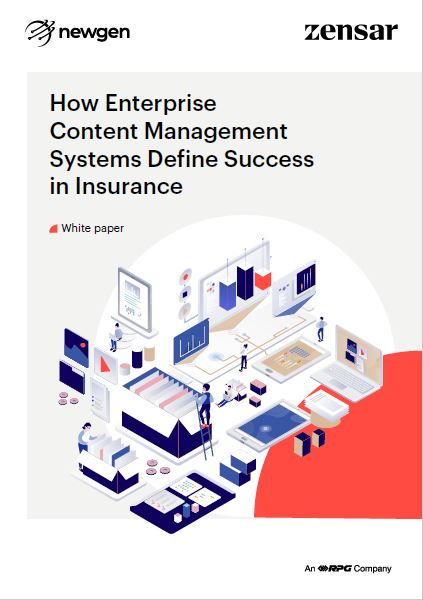From Paper Trails to Digital Intelligence: The Next Leap in Insurance Operations
The insurance industry is evolving faster than ever, yet many insurers still rely on legacy content management systems from the 1990s. These outdated systems, built for static document storage, cannot keep pace with the volume, variety, and velocity of content generated in today’s digital age — from emails and forms to videos, images, and social media interactions.
As a result, insurers face rising operational complexity, data silos, and slower decision-making. Content is scattered across disconnected systems, making it difficult for teams to locate, analyze, and act on information. The result — lower productivity, higher costs, and inconsistent customer experiences.
This whitepaper outlines how modern Enterprise Content Management (ECM) systems, powered by cloud, AI, and low-code capabilities, are redefining success for insurers by improving speed, compliance, collaboration, and customer satisfaction.
Why Legacy ECM Systems Are Holding Insurers Back?
Insurance carriers depend on a wide range of unstructured content — claims documents, policy forms, correspondence, and videos — yet traditional ECM systems struggle to handle this diversity.
Challenges of legacy ECM systems:
- Fragmented data scattered across multiple repositories.
- Manual retrieval processes that delay decision-making.
- Limited scalability and costly on-premises infrastructure.
- Poor integration with modern policy, billing, and claims platforms.
- Difficulty maintaining security and compliance across systems.
The result? Carriers waste hours searching for documents, struggle with reporting, and face increased regulatory risks.
To stay competitive, insurers must move from legacy to intelligent ECM platforms that deliver agility, automation, and actionable insights.
The Digital Imperative: Modernizing Content for the Cloud
Modern ECM solutions are not just storage tools — they’re content intelligence platforms that automate ingestion, classification, and processing.
Powered by AI, ML, RPA, and cloud-native architectures, next-generation ECM platforms help insurers:
- Ingest and process data in any format, from PDFs to videos.
- Apply intelligent indexing for instant search and retrieval.
- Analyze unstructured data for sentiment, intent, and context.
- Deliver omnichannel access to content across teams and devices.
- Strengthen compliance through audit-ready tracking and governance.
By integrating with Guidewire and similar cloud-based insurance platforms, insurers can create seamless, secure, and scalable content ecosystems that support faster claims, underwriting, and servicing decisions.
The Great ECM Standoff : Legacy vs. Modern
| Legacy ECM | Modern ECM (Content Services Platform) |
|---|---|
| On-premises, siloed, difficult to scale | Cloud-based and highly scalable |
| Hard to integrate with external systems | Low-code, API-ready, and integration-friendly |
| Designed for storage, not utilization | Focused on extracting value and insights from content |
| Heavy manual intervention | AI/ML-powered automation |
| Single repository, limited collaboration | Federated repositories enabling enterprise-wide access |
| Monolithic architecture | Modular, services-based architecture |
| Paper-centric workflows | Electronic, omnichannel document management |
The shift to modern ECM is not just an upgrade — it’s a strategic transformation that turns content into a competitive advantage.
What a Modern ECM Must Deliver?
According to Gartner, content services platforms are now foundational to enterprise success. For insurers, a future-ready ECM must offer five critical capabilities:
1. Omnichannel Content Capture and Processing
The ECM should handle structured and unstructured content from all sources — physical documents, emails, forms, or media files — and present a unified, searchable view.
Example: Adjusters can add annotations or bookmarks to claims videos, allowing faster review and collaboration.
2. Seamless Collaboration and Communication
Teams should be able to search, compare, share, and annotate content in real time across locations.
Example: A contact center representative can compare last year’s policy with the renewal version side-by-side to answer customer queries instantly.
3. Contextual Intelligence
AI and ML should analyze historical data, detect sentiment, and proactively surface relevant content.
Example: During a claim review, the ECM retrieves an old email or call recording from years ago, helping validate coverage decisions instantly.
4. Regulatory Compliance and Governance
The system should comply with evolving regulations like SEC 17a-4, maintain audit trails, and ensure content authenticity.
Example: Automated retention policies manage document lifecycles securely and in accordance with industry mandates.
5. Flexible, Scalable, and Secure Infrastructure
A cloud or hybrid ECM architecture ensures anytime, anywhere access, supporting remote teams and partner ecosystems while maintaining data security and privacy.
ECM as a Catalyst for Smarter Decision-Making
Modern ECM is not just a repository — it’s a decision enablement platform.
By providing access to real-time, contextual information, it enables:
- Faster policy creation and renewals.
- Streamlined claims processing.
- Enhanced collaboration between underwriters, agents, and adjusters.
- Stronger data security and compliance assurance.
When implemented with a cloud-based architecture like Newgen’s OmniDocs Content Services Platform, insurers can achieve measurable results — reduced turnaround times, improved accuracy, and higher operational efficiency.
The Newgen Advantage: Purpose-Built for Insurance
Newgen’s OmniDocs ECM, integrated with Guidewire, delivers contextual content services designed specifically for the insurance industry.
Core Capabilities:
- Ingest, classify, and process content in any format.
- AI/ML-based document classification and sentiment analysis.
- Real-time collaboration across distributed teams.
- Seamless integration with policy, billing, and claims systems.
- Secure, compliant, and scalable cloud deployment.
- Low-code flexibility for rapid configuration and updates.
Use Case Example:
An insurer managing complex auto and health claims implemented Newgen OmniDocs and reduced document retrieval time by 60%, improving claim turnaround and customer satisfaction.
Redefining Success: From Information to Intelligence
Success in modern insurance operations depends on how efficiently organizations leverage their content. Insurers that modernize their ECM are no longer reactive; they become data-driven, proactive, and customer-centric.
A modern ECM ensures:
- Operational Agility: Streamlined workflows and faster decision-making.
- Enhanced Experience: Omnichannel service delivery and transparency.
- Compliance Confidence: Secure, auditable data management.
- Future-Readiness: Integration-ready and scalable for tomorrow’s needs.
Transform Your Content Management with Newgen
It’s time to replace outdated systems with intelligent, cloud-ready ECM platforms that enable true digital transformation.

